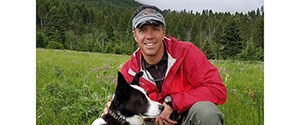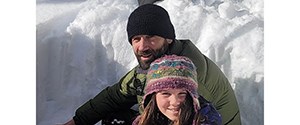Last updated: March 8, 2025
Article
When the River Breaks
In the aftermath of the devastating 2022 Yellowstone floods, we examined historical river flows. Could our insights help predict future events?
By Ally Marrs, Teodora Rautu, David Thoma, Ann Rodman, Mike Tercek, and Andrew Ray

Image credit: NPS
We rely on the historical behavior of rivers in ways we scarcely acknowledge. Floods, like wrecking balls, break these preconceived notions and raise questions about where we place infrastructure.
In June 2022, rivers in Yellowstone’s Northern Range exceeded century-long flood records. The flooding caused widespread damage and disrupted park operations, forcing the park to temporarily close to visitors. In the wake of the flood, many were left wondering what caused this natural disaster, if it could happen again, and whether there was a way to know what was coming ahead of time. We analyzed the historical flow record and worked on modeling the conditions that led to the disaster. Our findings can help alert scientists and land managers about future floods.
A Damaged Park Rebuilds
On the morning of June 13, 2022, officials at Yellowstone National Park recognized that the rivers in the northern part of the park were extremely high, creating dangerous conditions. They quickly made the decision to close the park temporarily to keep visitors and staff members safe. Roads began to flood, rocks and mud began to slide, and many locations lost power. The rivers were so high they carved new channels, washing out roads and causing bridges to collapse. Near Gardiner, Montana, a park housing unit plunged into the Yellowstone River and was flushed downstream. The widespread damage throughout the Northern Range prevented travel along a 50-mile corridor and temporarily isolated residents and visitors in Gardiner and Cooke City, Montana.

Image credit: NPS
After just nine days, the park reopened the southern loop to visitors. By July 2, 93 percent of roadways were open. Following months of hard work, the North Entrance was reopened to the public on October 30. The Old Gardiner Road, a gravel road connecting Gardiner, Montana, to Mammoth Hot Springs, was upgraded with pavement and guardrails to support visitors and local traffic.
“We need to design our infrastructure with these events in mind, knowing that they are going to start happening with greater frequency, greater intensity, and with a greater impact.”
As they were rebuilding, park managers considered how climate change might affect new infrastructure. Bob Kammel, chief of Professional Services at Yellowstone National Park, led the park’s post-flood damage assessments. “We have to look at how we design certain assets around not only flood events, but geothermal activity, earthquakes, wildfires,” said Kammel. “We need to design our infrastructure with these events in mind, knowing that they are going to start happening with greater frequency, greater intensity, and with a greater impact.”
Though the infrastructure damage was significant, the safety of employees and visitors was the park’s top priority. “We did the best we could without knowing it was coming,” said Yellowstone Park Ranger Tom Schwartz. Although the flood was a surprise, Yellowstone’s swift response ensured no visitors or staff members were injured. But Schwartz acknowledges that an early warning would have been incredibly useful.
Floods Are Getting Larger and Occurring Earlier
In the aftermath of this flood, we examined past flow records to better understand its magnitude in the context of history. For three of the Northern Range rivers (the Gardner, Lamar, and Yellowstone), we have about one hundred years of flow data collected at permanent U.S. Geological Survey streamflow gauging stations. Historical data provide insight on short- and long-term flow variation in free-flowing rivers like these. We gained context for the 2022 flood by comparing it to previous flow records.
We found that the Yellowstone River 2022 flood exceeded all previous floods at the Corwin Springs gauge since 1890. The volumetric flow rate measured by the gauge was 50 percent greater than the previous record, which translates to 17,000 cubic feet per second higher. The June 2022 floods were referred to as a “500-year flow event.” But this doesn’t mean a flood of this size couldn’t happen again sooner, particularly since precipitation extremes are becoming more frequent. It means that there is a 1-in-500 chance of a flood of this size happening in any given year.
We analyzed trends in high flows over time and found that flows in the 95th percentile—those that are greater than 95 percent of daily flows—have been increasing in size. This means that a 95th percentile flow in 2022 was larger than a 95th percentile flow in 1922. Not only is the amount of water flowing through these rivers changing, but also the timing of high flows. The peak flow date—the day of the year when the highest flow occurs—has been getting earlier over time for all three major Northern Range rivers. There are year-to-year variations, but on average, peak flow is occurring one day earlier every 11 years.

Image credit: NPS
Our takeaway from these findings is that the rivers’ baseline conditions—the conditions we use as a basis for comparison—are changing. We need to take these changes into consideration when designing new park infrastructure, relocating flood-vulnerable structures, or planning for future floods.
Because the baseline conditions are shifting, the past is no longer a good indicator of the future.
Although analyzing historical flow data helps us understand long-term trends, we cannot anticipate the size of future flood events with historic information alone. Because the baseline conditions are shifting, the past is no longer a good indicator of the future. For this reason, we must move away from a statistics-only approach and begin to use physical process models to anticipate conditions that have not occurred in the historic record. We have been working on a way to model the conditions that led to the 2022 event that may help provide an early warning of future floods.
A Model to Predict Floods
As water moves through the Northern Range it can be difficult to track. This is because water takes many forms, like rain, snow, or water vapor, and it flows above and below ground. Precipitation can be stored temporarily as snow or in soil, but when soil becomes saturated, additional snow melt or rain becomes runoff—surplus water that fills streams and rivers. Between storms, some water returns to the atmosphere through evaporation and plant transpiration, which means more water can then be stored in the soil.
We use a hydrologic model to help us understand how water moves through the environment. Using only temperature and precipitation data, we can calculate the amount and timing of precipitation stored as snow, the melt rate, soil moisture, and runoff. This model also helps estimate streamflow from soil moisture conditions and how much precipitation or snowmelt contributes to runoff. Understanding these complex processes is critical for anticipating future floods.
To determine how well the model can predict streamflow, we compared estimates of river flow to stream gauge measurements taken at the Lamar River from 1988 to 2022. The model performed remarkably well, accurately estimating the gauge-measured streamflow in most cases. The model found that the 2022 peak flow on the Lamar River was the highest flow since 1988, the starting point of this analysis. But it underestimated the 2022 peak flow compared to the gauge-measured peak. This is because it did not account for melted snow due to the heat added by rain, an effect called “rain on snow” that adds to runoff.

Image credit: NPS
We determined the degree of melting caused by warm rain using data from a U.S. Department of Agriculture SNOTEL (SNOw TELemetry) monitoring station in the Lamar River watershed. Data from this station show that 20 inches of water were stored in the snowpack at higher elevations on June 12, 2022, when approximately two inches of rain fell. The rain melted about two inches of water from the snowpack. This resulted in around four inches of runoff, causing the flooding. Because of this finding, we are working to incorporate the rain-on-snow effect in our model.
Compounded Effects Created “Perfect” Conditions
Based on SNOTEL measurements and our modeling, we concluded that the 2022 flood resulted when the rain-on-snow effect at higher elevations combined with rain falling on nearly saturated soils at lower elevations. Prior to the flood event, the soil where snow had already melted was close to its water-holding capacity. Rain falling on saturated soil is like rain falling on a parking lot: all of it runs off.
A similar amount of rain and snow melt likely occurred in the Gardner River watershed. There is no SNOTEL station in this watershed, so we relied on our model to make predictions for the Gardner River. By closely examining the runoff response to the storm in these two watersheds, we determined why past precipitation events that were similar to those in 2022 did not result in floods. We also found what conditions in 2022 transpired to make that year’s events unique.
Our analysis helps us understand why the 2022 floods were unprecedented and gives us tools to predict when floods like this may happen again.
In past cases, similarly sized storms occurred over several days and fell on drier soils, which absorbed much of the rain and slowed runoff. This averted flooding. Our model “understood” this. Our analysis helps us understand why the 2022 floods were unprecedented and gives us tools to predict when floods like this may happen again.
Another important finding of our work is that it takes time for water falling in the watershed to reach the river where it is measured by the U.S. Geological Survey stream gauges. This lag between the peak of precipitation and the flooding event means that our model gives us a small amount of lead time to provide alerts that flooding is possible. Using precipitation forecasts, we may be able to extend the alert time to a few days before a flood occurs.

Image credit: NPS
To do this, we feed “design storms” into the model, and it will tell us when floods are likely based on the size of the storm and the water content of soil in the watershed. In this way, we can test scenarios in real time to estimate flood sizes associated with approaching storms. This is possible because of our new understanding of flood mechanics in these watersheds.
Towards a More Predictable Future
Now more than ever, the National Park Service is contending with flooding and extreme weather events that are reshaping park resources. Park staff and visitors are personally affected by these events, which can endanger lives and property. Yellowstone Superintendent Cam Sholly said the 2022 floods caused him to change the way he talks to people about climate change.
“These events continue to help shape the conversation about the future, even galvanizing people who were previously divergent on climate change.”
“These events continue to help shape the conversation about the future, even galvanizing people who were previously divergent on climate change,” he said. “Whether looking at future impacts to resources, economics, or recreational access, this flood negatively affected a lot of people, and these events will continue to be more frequent in the future. The question is, how do we better prepare ourselves to deal with what’s coming?”
The 2022 floods in Yellowstone National Park follow global predictions about flooding hazards in the face of climate change. Such incidents are likely to become more frequent and more intense. We retrospectively modeled flood flows in Northern Range rivers to show the environmental conditions that contributed to the historic 2022 flooding. Using these same approaches, we may be able to program alerts using near real-time information and give early warning of future dangerous flood conditions.
Using flow data from the past century, we also discovered that these river systems have been changing over time, and we can use this knowledge to inform and improve our models. The historic nature of the 2022 floods in Yellowstone National Park showed us how crucial it was to quantify climate-induced changes in flood frequency and size over the last century. The insights we gained from our research will help National Park Service scientists and land managers predict such events and thereby reduce associated risks.
About the authors

Ally Marrs is a graduate student studying stream ecology and biogeochemistry at Utah State University. Her research focus is greenhouse gas emissions from rivers and canals. She was a 2022 Scientists in Parks Fellow at the Greater Yellowstone Inventory and Monitoring Network, where she analyzed long-term water quality and streamflow data from the Yellowstone River. Image credit: NPS

Teodora Rautu is a graduate student in biological sciences at Montana State University. She is studying how whitebark pine affects streamflow and snowpack dynamics in the Greater Yellowstone Ecosystem. Image courtesy of Teodora Rautu.

David Thoma is a landscape ecologist with the Northern Colorado Plateau Inventory and Monitoring Network. Image courtesy of David Thoma.

Ann Rodman is the supervisory GIS specialist in the Yellowstone Center for Resources. Image courtesy of Ann Rodman.

Mike Tercek is the founder of Walking Shadow Ecology. Image courtesy of Mike Tercek.

Andrew Ray is a program manager with the National Park Service’s Southern Plains Inventory and Monitoring Network. He was an aquatic ecologist with the Greater Yellowstone Inventory and Monitoring Network from 2012 to 2022. Image courtesy of Andrew Ray.
